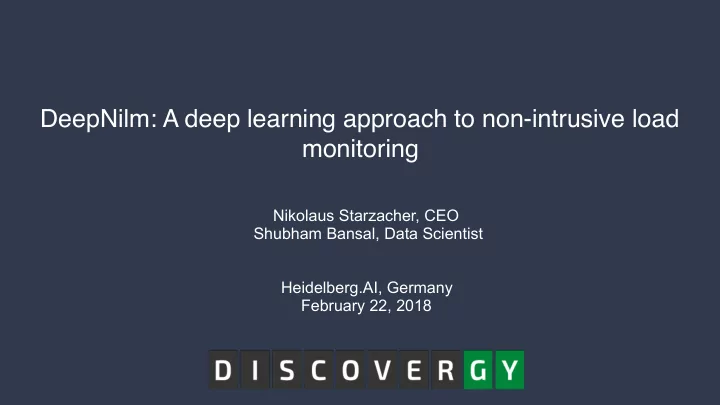

DeepNilm: A deep learning approach to non-intrusive load monitoring Nikolaus Starzacher, CEO Shubham Bansal, Data Scientist Heidelberg.AI, Germany February 22, 2018
Discovergy in a Nutshell • Founded in 2009 by Ralf Esser and Nikolaus Starzacher • Located in Heidelberg and Aachen • Smart Metering for consumers and businesses • Communication Gateway developed in-house • Compatible with any meter for any medium • Scaleable backend infrastructure for Storage , Visualisation , Alerting , Engagement , Disaggregation and Value Added Services • Independent metering operator for Electricity and Gas • Nationwide network of installers • Discovergy offers full-stack metering operations in Germany
Discovergy in a Nutshell
The problem • Buildings account for 20-40% of primary energy consumption. • About 20% of this can be saved through energy efficiency improvements. • It is believed that these reductions have not been achieved due to behavioural barriers Energy consumption is a black-box for most people Image source: Armel, K. Carrie, et al. "Is disaggregation the holy grail of energy efficiency? The case of electricity." Energy Policy 52 (2013): 213-234.
How can we open up the black box? Direct monitoring of each appliance • Connect each relevant appliance to a smart plug. • Typical smart plug costs € 30. For a typical household the total cost could go upwards of € 300. • High accuracy but can get super expensive
How can we open up the black box? Non intrusive load monitoring (NILM) • Statistical/Machine learning techniques can be used to infer the appliance level energy consumption from the aggregate • Growth in the installation of smart meters which report data at 15 min intervals and faster.
Benefits of Non-intrusive load monitoring Better understanding of electricity consumption Demand response
Benefits of Non-intrusive load monitoring Predictive maintenance & Personalised energy savings tips faulty appliance detection & notifications
Requirements for NILM Algorithm Works well with data resolutions around 1 Hz ● Generalises well to buildings and homes not seen in the training data ● Modular and flexible: Easy to add models for new appliances ● Computationally scalable during inference ● High accuracy in appliance detection ● Works like magic ! ●
Typical 3-phase smart meter data
Approach Feature Disaggregated Raw data engineering Clustering Labelling data & extraction Disaggregated Raw data Deep learning data
Inspiration - Image Detection & Localisation
Inspiration - Image Detection & Localisation Background Clutter
Inspiration - Image Detection & Localisation Occlusion
Inspiration - Image Detection & Localisation Electric Car Washing machine Intra-class variation
Scheme Device specific classifier
Deep Learning Input window We can answer - How many times a Deep device was operated neural and at what time ? network - How much energy it ~15 -20 Layers consumed during each of those runs ? Prediction box 1 : ● Start time ● End time ● Mean power 1) Kelly, J., & Knottenbelt, W. (2015, November). Neural nilm: Deep neural networks applied to energy disaggregation. In Proceedings of the 2nd ACM International Conference on Embedded Systems for Energy- Efficient Built Environments (pp. 55-64). ACM.
Generalisation Performance to Unseen Houses Washing Machine Metrics Train Validation Test Mean Absolute Error (W) 38.86 42.64 10.11 Relative Error 0.1091 0.1082 0.2535 F1 Score 0.9704 0.9595 0.9163 Precision 0.9680 0.9513 0.9107 Recall 0.9727 0.9678 0.9219
Disaggregation in action
Peeking under the hood
Baseline Invariant Predicted appliance energy should be invariant to the baseline Predict and Validation Add calculate data baseline error Data augmentation helps
Translation Invariant
What Features are Important ? You can view the video here: link
Features Learnt - First Convolutional Layer Filter 2 behaves like a rectified difference series Filter 3 is detecting negative edges Filter 7 is detecting large negative edges Filter 8 is detecting large positive edges Filter 9 is tracking high magnitudes Activations from the conv1 layer
Zoomed in View Filter 2 behaves like a rectified difference series Filter 8 is detecting large positive edges Filter 13 is detecting sort of minimum in the input
1 t-SNE Visualization ● t-distributed Stochastic Neighbour Embedding ● Dimensionality reduction technique ● Preserves pairwise distances approximately ● Take the activations from the last layer before the prediction layer and reduce them to 2-dimensions using t-SNE 1. L.J.P. van der Maaten and G.E. Hinton. Visualizing High-Dimensional Data Using t-SNE . Journal of Machine Learning Research 9(Nov):2579-2605, 2008.
t-SNE Visualization Input windows without washing machine activation Input windows with washing machine activation
Challenges that we want to tackle Take an unsupervised approach for machine learning. Tons ● and tons of unlabelled data Personalise and tweak the appliance models for each user ● Incorporate user feedback into improving the models ●
High frequency data - Rich Fingerprints NILM: 8kHz - VI Trajectories
High frequency data - Rich Fingerprints
Thank you Shubham Bansal Data Scientist, Discovergy GmbH Say hi to me at sb@discovergy.com
Recommend
More recommend